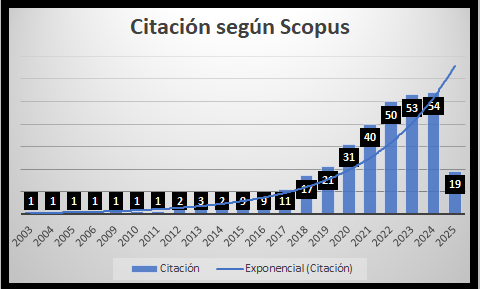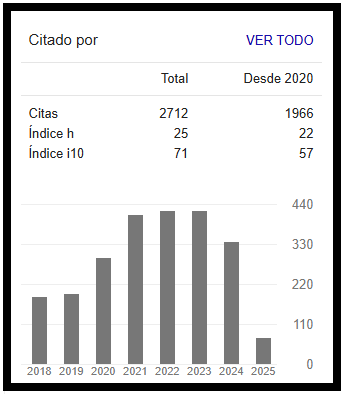Journal data
- ISSN: 2224-235X
- E-ISSN: 2304-2265
- Format: electronic / Open Access
- Frequency: semi-annual publication / early published
- Peer review system: double anonymized review
- Charges: no
The Correspondencias & análisis journal complies with the quality criteria and indicators in its editorial process, which are: impact and prestige, visibility and accessibility, punctuality and seriousness, rigor and process, ethics and commitment, editorial management, scientific community, originality and authorship.
Impact and prestige:
Correspondencias & análisis journal is present in 109 international databases: 24 open access databases, 11 publication evaluation platforms, 22 selective scientific portals and directories, and 52 library catalogs around the world.
Visibility and Access:
Correspondencias & análisis maintains a policy of access to open and shared knowledge, having all its 201 published articles, available on the journal's website and on the OJS platform, completely free of charge and in full text. In addition to being a bilingual publication with versions in 02 languages: Spanish, English. The international visibility of Correspondences & Analysis originates from its different access formats (pdf, html, xml and ePub), in different academic social networks (AcademiaEdu, ResearchGate) and generic (LinkedIn, Twitter), author identifiers (ORCID, DOI ), as well as in document managers such as Mendeley.
Punctuality and Seriousness:
The periodicity of the publications is biannual and is guaranteed by an efficient flow of manuscripts. In a meticulous, rigorous and explicit way in the publication rules, the authors can follow the entire process of receiving and evaluating the manuscripts:
1. In the first instance, the manuscripts received are evaluated by the Scientific Council, considering the theme, the form and the relevance of the article (10 calendar days).
2. In the second instance, the articles are sent to two external evaluators, considered experts in the subject, having a maximum of 30 days to submit their reports, through an article evaluation format.
3. In the third instance, once the evaluation of the manuscript has been completed, the author receives a notification of the opinion of the peers, where the observations, comments and/or suggestions issued by them are indicated verbatim. Said opinion is sent with one of the following notifications: a) approved, b) recommended with specific changes, c) conditioned or d) rejected.
4. Editing of texts and publication of the new issue in online format.
Rigor of the Process:
Correspondencias & análisis guarantees a rigorous and transparent system of anonymous arbitration of peer review, through an International Scientific Committee of Reviewers from different countries on five continents, specialists in communication and advertising. Each manuscript is submitted to a minimum of two blind reviews, by experts in the field.
Ethics and Commitment:
Correspondencias & análisis journal has an ethical code that guarantees the rights and duties of the entire scientific community: authors, reviewers and editors. The Correspondence & Analysis code of ethics, based on the International Committee of Publication Ethics (COPE), regulates the commitments that all authors acquire regarding originality in the authorship of the works, access to data, conflict of interest, correction of errors and responsibility. The reviewers, for their part, commit to honest and constructive criticism, respect for time, confidentiality and maximum objectivity to avoid redundancies or conflicts of interest. Finally, the editors guarantee the ethics and commitment of Correspondencias & análisis, assuming an honest and objective practice, ensuring the optimal selection of reviewers, confidentiality and the utmost respect for the deadlines.
Editorial Management:
Correspondence & Analysis guarantees the quality of the editorial process through the OJS 3.1.1.2 Platform. The scientific rigor of the texts is based on editorial neatness, based in turn on the work of national and foreign reviewers (most of them from Spain, Mexico, Argentina, Chile, Colombia, among others), a professional layout and the adaptation to different online publishing formats for better visualization and impact (PDF, HTML, XML, Epub). The journal has a very rigorous and serious editorial process, it is accessible on the web (totally free in full text) and transparent for the author throughout the process (from receipt of the manuscript, evaluation by double-blind reviewers, opinion of the reviewers and the acceptance or rejection of the manuscript).
Scientific Community:
Correspondencias & análisis has an important scientific community of national authors (88), foreign authors (216), national reviewers (30), foreign reviewers (130) and readers around the world. In addition, it has a solid editorial team that collaborates intensively in the growth and consolidation of the magazine.
Emerging Technologies:
Both the editorial process, as well as the subsequent dissemination and impact, progressively, and according to technological advances, are continually adapting to emerging technologies, which implies that adjustments are made from time to time and they are modified or incorporated. new display formats for articles, improvements in communication models with authors and/or reviewers, and updating of new versions of the platform for use for editorial management (OJS) and the process of disseminating published articles . For this reason, Correspondencias & Análisis magazine has a network of national and international collaborators, and maintains open communication networks, in order to increase the impact of published articles.
Originality and Progress:
In Correspondencias & análisis the originality of the work is paramount. For this reason, all manuscripts, from the beginning, are subjected to plagiarism controls (Turnitin). According to the journal's regulations, plagiarism is an automatic reason for immediate rejection of an investigation and the author is excluded from successive calls. Only unpublished and original articles are published around the areas of communication sciences, which guarantee true scientific research where the results presented provide relevant and interesting data for our scientific community. In this sense, the publications of the magazine are aimed at the progress of science in the field of communication media.
Authorship:
In Correspondencias & análisis, the author is the main figure, who initiates and sustains the entire process of editorial management, always prevailing originality and novelty. The editorial committee aspires to achieve the greatest visibility of the journal, academic excellence and respect for the authors.

 |
2.png) |
 |
 |







 Licencia Creative Commons Atribution 4.0 International (CC BY 4.0)
Licencia Creative Commons Atribution 4.0 International (CC BY 4.0)
Address: Av. Tomás Marsano Nº 242, Surquillo. Lima - Perú
Phone: (51-1) 513-6320 - Extension: 2190
E-mail: revista_cya@usmp.pe
Web: https://ojs.correspondenciasyanalisis.com/index.php/Journalcya
DOI: https://doi.org/10.24265/cian
ISSN: 2224-235X (Print)
2304-2265 (Online) 
